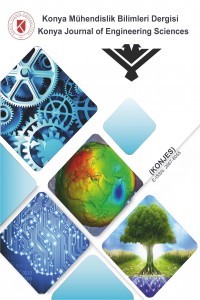İKİLİ KÜP MODELLERİNİN AKIŞ ALANINA FARKLI AÇIKLIK ORANLARINDA YERLEŞTİRİLMESİNİN AKIŞ YAPISINA ETKİSİNİN DENEYSEL OLARAK İNCELENMESİ
Kübik cisimler, Akış yapısı, PIV, D/h
Experimental Investigation of The Effect of Placing Dual Cube Models in The Flow Field with Different Gap Ratios on Flow Structure
Cube, Flow structure, PIV, D/h,
___
- Alnak, D. E., Varol, Y., Firat, M., Oztop, H. F., & Ozalp, C., 2019, “Experimental and numerical investigation of impinged water jet effects on heated cylinders for convective heat transfer.”, International Journal of Thermal Science, Vol. 135, pp. 493-508.
- Castro, I. P., Robins, A. G., 1977, “The flow around a surface-mounted cube in uniform and turbulent streams”, Journal of fluid Mechanics, Vol. 79 No. 2, pp. 307-335.
- Çengel, Y. A., Cimbala, J. M., & Engin, T. (2008). Akışkanlar Mekaniği: Temelleri ve Uygulamaları. Güven Kitabevi.
- Diaz-Daniel, C., Laizet, S., & Vassilicos, J. C., 2017, “Direct numerical simulations of a wall-attached cube immersed in laminar and turbulent boundary layers.”, International Journal of Heat and Fluid Flow, Vol 68, pp. 269-280.
- Guichard, R., 2019, “Assessment of an improved Random Flow Generation method to predict unsteady wind pressures on an isolated building using Large-Eddy Simulation”, Journal of Wind Engineering and Industrial Aerodynamics, Vol. 189, pp. 304-313.
- Joubert, E. C., Harms, T. M., Venter, G., 2015, “Computational simulation of the turbulent flow around a surface mounted rectangular prism”, Journal of Wind Engineering and Industrial Aerodynamics, Vol. 142, pp. 173-187.
- Klotz, L., Goujon-Durand, S., Rokicki, J., & Wesfreid, J. E., 2004, “Experimental investigation of flow behind a cube for moderate Reynolds numbers”, Journal of Fluid Mechanics, Vol. 16, pp. 1630-1646
- Kundu, P. K., Cohen, I. M., & Dowling, D. R., 2016, Fluid mechanics, 6th version, Academic, Berlin.
- Lin, K. C., Violi, A., 2010, “Natural convection heat transfer of nanofluids in a vertical cavity: Effects of non-uniform particle diameter and temperature on thermal conductivity”, International Journal of Heat and Fluid Flow, Vol. 31, No. 2, pp. 236-245.
- Liu, S., Pan, W., Zhao, X., Zhang, H., Cheng, X., Long, Z., Chen, Q., 2018, “Influence of surrounding buildings on wind flow around a building predicted by CFD simulations”, Building and Environment, Vol. 140, pp. 1-10.
- Ozgoren, M., 2006, “Flow structure in the downstream of square and circular cylinders”, Flow Measurement and Instrumentation, Vol. 17 No. 4, pp. 225-235.
- Özalp, C., Polat, C., Saydam, D. B., Söyler, M., 2020, “Dye Injection Flow Visualization Around a Rotating Circular Cylinder”, European Mechanical Science, Vol. 4, No. 4, pp. 185-189.
- Park, J., Sun, X., Choi, J. I., Rhee, G. H., 2017, “Effect of wind and buoyancy interaction on single-sided ventilation in a building”, Journal of Wind Engineering and Industrial Aerodynamics, Vol. 171, pp. 380-389.
- Polat, C., 2019, Farklı Dizilimlere Sahip Binalar Etrafındaki Akış Karakteristiklerinin PIV Yöntemi ile Deneysel Olarak İncelenmesi, Yüksek Lisans Tezi, Osmaniye Korkut Ata Üniversitesi, Fen Bilimleri Enstitüsü, Osmaniye.
- Princevac, M., Baik, J. J., Li, X., Pan, H., Park, S. B., 2010, “Lateral channeling within rectangular arrays of cubical obstacles”, Journal of Wind Engineering and Industrial Aerodynamics, Vol. 98, No. 8-9, pp. 377-385.
- Sari, D. P., Kusumaningrum, W. B., 2014, “A technical review of building integrated wind turbine system and a sample simulation model in central java, Indonesia”, Energy Procedia, Vol. 47, pp. 29-36.
- Tominaga, Y., Akabayashi, S. I., Kitahara, T., Arinami, Y., 2015, “Air flow around isolated gable-roof buildings with different roof pitches: Wind tunnel experiments and CFD simulations”, Building and Environment, Vol. 84, pp. 204-213.
- Thompson, D., 2019, “Effect of wall proximity on the flow over a cube and theimplications for the noise emmited.”, Physics of Fluids, Vol. 31 No.7, pp. 077101
- Tutar, M., Oğuz, G., 2004, “Computational modeling of wind flow around a group of buildings”, International Journal of Computational Fluid Dynamics, Vol. 18, No. 8, pp. 651-670.
- Wang, Y. Q., Jackson, P. L., & Sui, J., 2014, “Simulation of Turbulent Flow Around a Surface-Mounted Finite Square Cylinder.”, Journal of Thermophysics and Heat Transfer, Vol. 28 No.1, pp. 118-132.
- Yakhot, A., Liu, H., Nikitin, N., 2006, “Turbulent flow around a wall-mounted cube: A direct numerical simulation”, International Journal of Heat and Fluid Flow, Vol. 27, No. 6, pp. 994-1009.
- Yayın Aralığı: Yılda 4 Sayı
- Başlangıç: 2004
- Yayıncı: Konya Teknik Üniversitesi
KENEVİR ATIKLARININ KARBONİZASYONU VE AKTİF KARBON ELDESİ
Aydan AKSOĞAN KORKMAZ, Yunus ÖNAL
Muhammed Salih GÜL, Hasan GÖKKAYA, Bilgehan KONDUL, Muhammet Hüseyin ÇETİN
Gayrimenkul Fiyat Tahmini ve Alttaki Özelliklerin Analizi İçin C4.5 – CART Karar Ağacı Modeli
Sait YÜCEBAŞ, Melike DOĞAN, Levent GENÇ
Didem ŞEN KARAMAN, Ayşenur PAMUKÇU
Bilgehan KEKEÇ, Dhikra GHİLOUFİ
SEPİYOLİT CEVHERİNİN GENEL ÖZELLİKLERİ VE ISIL DAVRANIŞI
Hilal Asya KARABULUT, Yasemen KALPAKLI
FARKLI TÜR BOR MİNERALLERİNİN JEOPOLİMER ESASLI HARÇLARIN MEKANİK VE MİKRO YAPI ÖZELLİKLERİNE ETKİSİ
TÜRKİYE’DEKİ DEMİRYOLU ENERJİ TÜKETİMİNİN YAPAY SİNİR AĞLARI İLE TAHMİN EDİLMESİ
Emre KUŞKAPAN, Merve Kayacı ÇODUR, Muhammed Yasin ÇODUR
MS HASTALIĞININ TEDAVİSİNE YÖNELİK YENİ SFİNGOSİN-1-FOSFAT RESEPTÖR MODÜLATÖRLERİNİN GELİŞTİRİLMESİ
Cemre POLAT, Doğan Burak SAYDAM, Mustafa SÖYLER, Coskun ÖZALP
